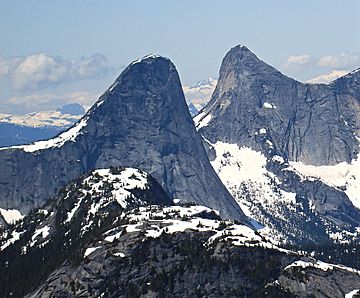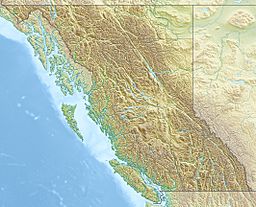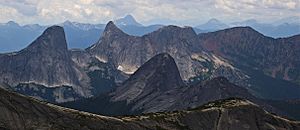Ibex Peak (British Columbia) facts for kids
Quick facts for kids Ibex Peak |
|
|---|---|

Steinbok Peak (left) and Ibex Peak (right)
|
|
| Highest point | |
| Elevation | 2,039 m (6,690 ft) |
| Prominence | 474 m (1,555 ft) |
| Parent peak | Guanaco Peak (2127 m) |
| Geography | |
| Location | British Columbia, Canada |
| Parent range | North Cascades |
| Topo map | NTS 92H/11 |
| Climbing | |
| First ascent | 1962 by Asger Bentzen, Hamish Mutch, Glenn Woodsworth, Bob Woodsworth |
| Easiest route | Scrambling via northwest slope |
Ibex Peak is a tall mountain in the North Cascades range, located in southwestern British Columbia, Canada. It stands about 2,039-metre (6,690-foot) high. This mountain looks like a horn and is made of granite.
You can find Ibex Peak about 13 km (8 mi) west-northwest of Coquihalla Summit. It's also only 1 km (1 mi) northwest of Steinbok Peak. The water from Ibex Peak flows into the Anderson River.
The mountain was named after the ibex, which is a type of wild goat. This name fits with other nearby mountains that are also named after ungulates (hoofed animals). The name "Ibex Peak" became official on February 5, 1976.
Contents
How Mountains Formed Here
The Cascade Range, where Ibex Peak is located, started forming millions of years ago. This happened during a time called the late Eocene Epoch.
Moving Plates and Volcanoes
The Earth's surface is made of huge pieces called plates. The North American Plate is slowly moving over the Pacific Plate. This movement caused lots of volcanic activity in the past.
Also, small pieces of the Earth's crust, called terranes, joined together to create the North Cascades about 50 million years ago.
Ice Age and Shaping the Land
About two million years ago, during the Pleistocene period, huge sheets of ice called glaciers covered the land. These glaciers moved forward and then melted back many times.
As they moved, they carved out the land, creating "U"-shaped river valleys. The combination of the land pushing up (called uplift) and cracks in the Earth (called faulting), along with the glaciers, created the tall peaks and deep valleys we see today in the North Cascades.
The North Cascades has some of the most rugged land in the Cascade Range. You can see jagged peaks, sharp ridges, deep glacial valleys, and tall granite spires. All these geological events created the different landscapes and big changes in height across the Cascade Range. This also led to different climates and types of plants in the area.
Weather at Ibex Peak
Ibex Peak is in a marine west coast climate zone. This means it gets a lot of rain and snow.
How Weather Works Here
Most of the weather comes from the Pacific Ocean. Weather systems travel east towards the Cascade Range. When they hit the mountains, the air is forced to rise. As the air goes up, it cools down and drops its moisture. This causes a lot of rain or snow, especially in winter. This process is called Orographic lift.
Temperatures and Best Time to Visit
Temperatures on Ibex Peak can get very cold, sometimes below −20 °C. With the wind, it can feel even colder, below −30 °C. If you want to climb Ibex Peak, the best weather is usually from July through September.
Climbing Routes
People have found several ways to climb Ibex Peak. Here are some of the established routes:
- Northwest Slope - This route was first climbed in 1962. It's rated class 3, which is a relatively easy climb.
- Southwest Ridge - This route was first climbed in 1981 and is rated class 5.9.
- East Ridge/Face - This route was first climbed in 1982 and is rated class 5.10.
- Trivial Pursuits - This route was first climbed in 1995 and is rated class 5.10+.
- South Face (Proof Is In The Pudding) - This route was first climbed in 2003 and is rated class 5.10c.




